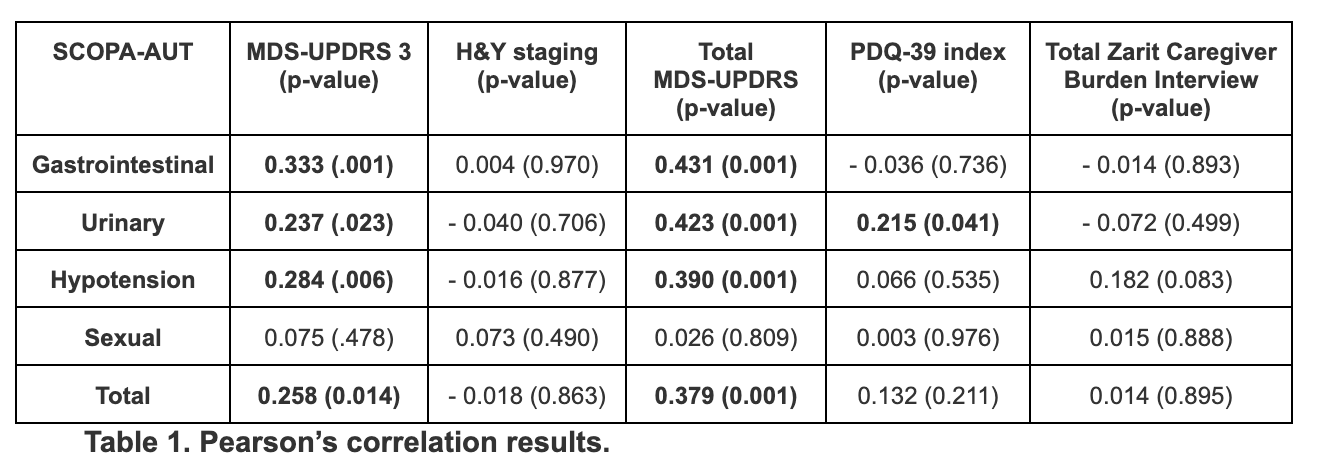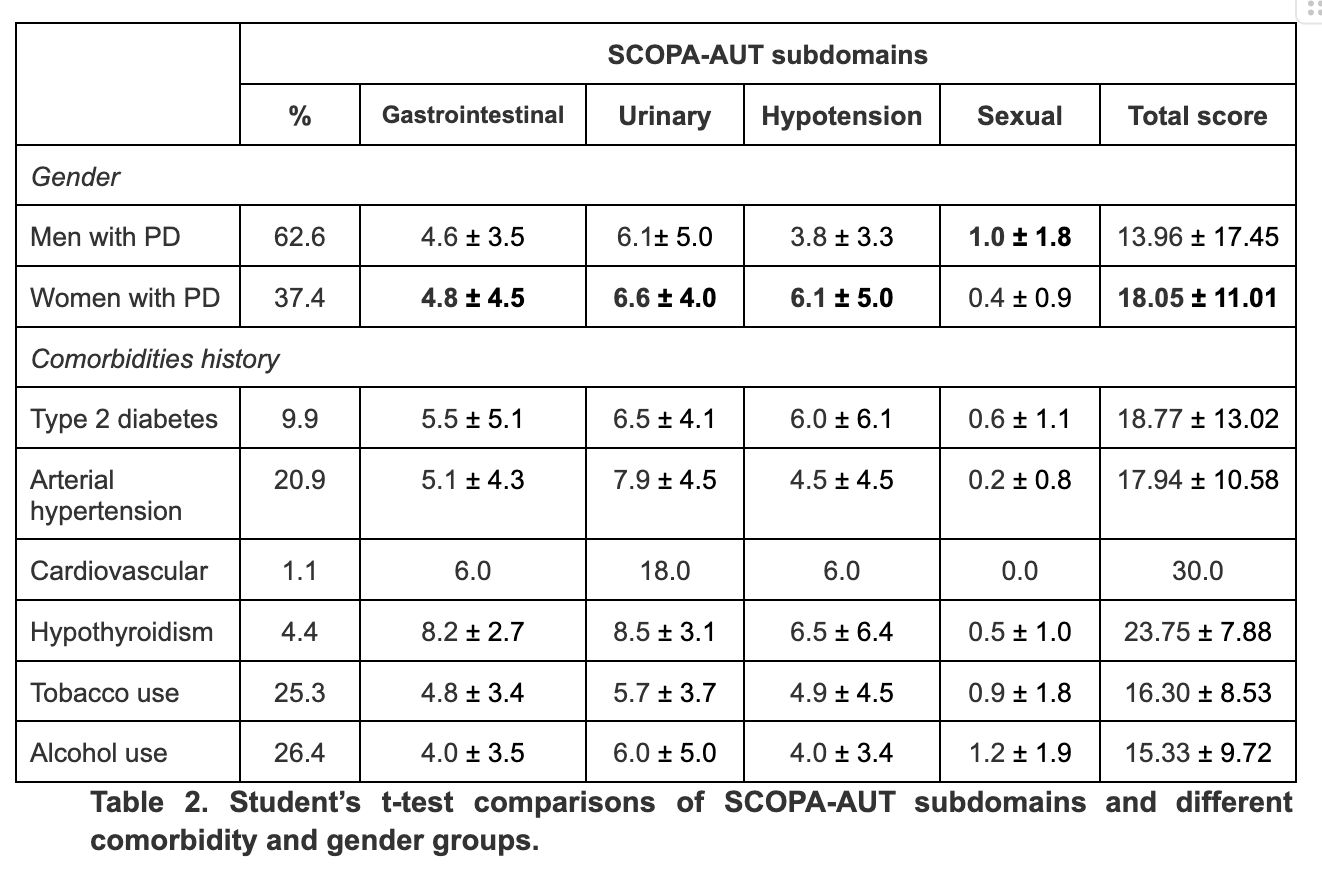Category: Parkinson's Disease: Non-Motor Symptoms
Objective: To highlight the impact and correlation of autonomic dysfunction in motor symptoms, quality of life and caregiver burden from PwP
Background: Autonomic dysfunction (AD) is a significant non-motor aspect PwP, manifesting in both early and advanced stages of PD [1]. Within the realm of autonomic disorders, cardiovascular, urogenital, gastrointestinal, and sexual dysfunctions are especially noteworthy [2]. Certain studies propose that the premature onset of AD not only diminishes the quality of life for PwP but also intensifies motor dysfunction and adds to the economic burden of PwP [3]. This study aims to highlight the impact and correlation of AD in motor symptoms, quality of life and caregiver burden from PwP
Method: Mexican PwP were included in this cross-sectional observational study. AD was assessed using the SCOPA-AUT divided in subdomains: (i) Gastrointestinal disorders, (ii) Urinary disorders, (iii) Cardiovascular disorders/hypotension, (iv) Sexual disorders. Pearson’s correlation method was used to evaluate MDS-UPDRS III, ZCBI and PDQ-39i. In addition, student T-test was carried out with sociodemographic variables, such as gender, age, socioeconomic status, type 2 diabetes, arterial hypertension and dyslipidemias. Finally, linear regression was performed for identifying risk factors for higher scores in SCOPA-AUT.
Results: 91 Mexican PwP (62.6% males; 63.02 ± 11.09 years old). Subdomains (i), (ii) and (iii) were strongly correlated with MDS-UPDRS III (p=0.001, 0.023 and 0.006, respectively) and with total MDS-UPDRS (p=0.001, 0.001 and 0.001, respectively). Moreover, (ii) domain was correlated with PDQ-39i (p=0.005) [Table 1]. Surprisingly, women showed higher scores in the subdomains compared with men, except in the (iv) domain [Table 2]. Type 2 diabetes (p=0.048) was identified as an independent risk factor. Other predictors included in the analysis did not show a statistically significant influence.
Conclusion: This study suggests a notable correlation between AD, MDS-UPDRS, and gender differences among Mexican participants. Additionally, type 2 diabetes emerged as a significant risk factor, highlighting potential associations with the severity of PD symptoms in this population. Understanding the intricate connection between AD and PD is crucial for developing more effective treatments, ultimately enhancing the day-to-day lives of PD patients and their caregivers.
Pearson´s correlation results
T-test comparisons of SCOPA-AUT subdomains
References: 1.- Ronald F. Pfeiffer, Autonomic Dysfunction in Parkinson’s Disease, Neurotherapeutics, Volume 17, Issue 4, 2020, Pages 1464-1479, ISSN 1878-7479
https://doi.org/10.1007/s13311-020-00897-4
2. Wolfgang H. Jost, Chapter Twenty-Five – Autonomic Dysfunction in Parkinson’s Disease: Cardiovascular Symptoms, Thermoregulation, and Urogenital Symptoms, Editor(s): K. Ray Chaudhuri, Nataliya Titova, International Review of Neurobiology, Academic Press, Volume 134, 2017, Pages 771-785, ISSN 0074-7742, ISBN 9780128126035, https://doi.org/10.1016/bs.irn.2017.04.003
3. Zhichun Chen, Guanglu Li, Jun Liu, Autonomic dysfunction in Parkinson’s disease: Implications for pathophysiology, diagnosis, and treatment, Neurobiology of Disease, Volume 134, 2020, 104700, ISSN 0969-9961 https://doi.org/10.1016/j.nbd.2019.104700
To cite this abstract in AMA style:
MF. Medina Pérez, D. Lopez Galindo, AJ. Hernandez Medrano, DP. Romero Terán, SF. Arechavala Lopez, G. Rivera Monroy, KI. Sanchez Ramirez, A. Abundes Corona, A. Cervantes Arriaga, M. Rodríguez Violante. Autonomic dysfunction and its impact on quality of life in Mexican people living with PD [abstract]. Mov Disord. 2024; 39 (suppl 1). https://www.mdsabstracts.org/abstract/autonomic-dysfunction-and-its-impact-on-quality-of-life-in-mexican-people-living-with-pd/. Accessed April 1, 2025.« Back to 2024 International Congress
MDS Abstracts - https://www.mdsabstracts.org/abstract/autonomic-dysfunction-and-its-impact-on-quality-of-life-in-mexican-people-living-with-pd/


